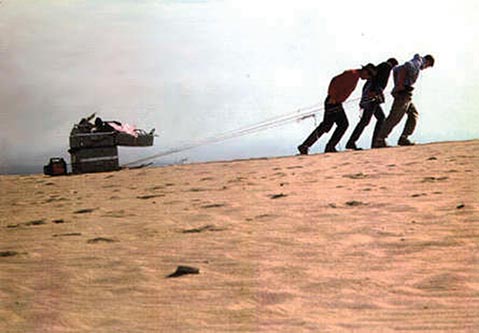‘The Lost City of Cecil B. DeMille’
Filmmaker Peter L. Brosnan

Many Santa Barbara residents have a vague appreciation that the Hollywood epic, The Ten Commandments, was filmed in the sand dunes of Guadalupe. This thoroughly researched and surprisingly dramatic documentary showcases one man’s decades-long quest to unearth the forgotten movie sets — and the wealth of archaeological, old movie culture evidence therein — focusing sharply on many of the ridiculous hurdles he faces along the way.
WORLD PREMIERE
After three or so decades, are you relieved to have this film finished?
“Relieved” is an understatement. Most of the interviews and footage were shot 25 years ago or more. It has all been sitting in boxes in my garage ever since. I am delighted it is finally seeing the light of day. But I certainly hope that work on the site will continue. We have saved so little from the early days of the American motion picture industry —it’s estimated that perhaps 95% of all the American made silent films are “lost.” DeMille buried enough in the Guadalupe Dunes to fill several museums. I really hope that continued work on the site will bring a fresh appreciation of the importance of early Hollywood.
DeMille was clearly one of the titans of Hollywood in its critical infancy. Do you think he gets the recognition he deserves today?
Belatedly. For years it was fashionable to look at his films as overblown or corny. In reality, he was the one who showed other filmmakers how to fill a screen with epic, grand, and exciting images that had never been seen in any other medium before. His contribution to the creation of
“Hollywood,” and to the art and science of motion pictures, is second to none. I think that is now being more widely recognized.
It’s interesting that this became a true archeology project.
It began as archaeology. When Bruce Cardozo, Richard Eberhardt, and I “discovered” the set in 1983, we realized that the tools and disciplines of archaeology would be vital to saving not just buried statues, but a record of the lives of the people who worked on the set. One of our first moves was to contact the archaeologists, including Dr. Brian Fagan (UCSB), Dr. Paul Chace (California Society of Archaeology), Dr. Ray Brandis (University of San Diego). and Dr. Robert
Hoover (Cal Poly SLO), who were all early supporters of our efforts.
Are there any film shoots today of this magnitude?
No. There are still wonderful epic films, but no more armies of extras. The grand scenes are now done by an army of kids with apps.
The County of Santa Barbara planning department is clearly the enemy in this film. Were you aware that they are considered one of the strictest departments in the country when you set out to do this, or did you have to learn that the hard way?
We were aware of their reputation, and we tried to play by their rules. The problem was, they kept changing their rules. In a weird kind of way, I am grateful to the permit people. They gave this film something I never expected it to have: a heavy. Made for a much better film.
Did you ever get a better understanding of why they had problems with your archaeologist colleague?
No.
Is there hope for more excavation in the future? Do you believe there is more to be found?
There is enough American Cinema history buried in Guadalupe to keep archaeologists busy for decades. I hope that will be the case.
The City of Guadalupe is on the continual brink of collapse, and has even considered dis-incorporating. Do you think a proper showcase of these ruins could bring more tourism and economic vibrancy to the area?
The city of Lone Pine has made a healthy tourist industry out of its movie history. Guadalupe could do the same. Perhaps a “classic movie festival” — in the “classic town”
of Guadalupe — would help bring attention to this wonderful, and well preserved, gem of a town. They are right in the middle of the Hollywood-to-Hearst Castle tourist route.
What is the best way for the everyday Santa Barbaran to learn more about this lost city?
Visit the Dunes Center in Guadalupe. Their exhibits and staff are wonderful. And, of course, watch our movie.
What other projects are you working on?
No other film projects. I have a full time family, and a full time career with Los Angeles County. That’s enough projects.



